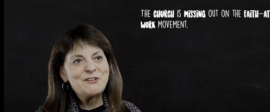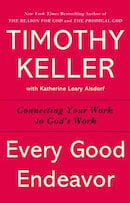The Transfiguration
Daily Reflection / Produced by The High Calling
Then Elijah and Moses appeared and began talking with Jesus.
Mark 9:4
Truly, the story of the Transfiguration of Jesus is one of the strangest in the Gospel of Mark. The basic facts are clear enough. Jesus took Peter, James, and John up on a mountain, where Jesus’ appearance changed as he became “dazzling white” (9:3). “Then Elijah and Moses appeared and began talking with Jesus” (9:4). Unfortunately, Mark does not tell us what they talked about. But we do get to see the sweetly confused Peter, who offered to make shelters for Jesus, Moses, and Elijah (9:5-6). Mark adds that Peter made this offer because “he didn’t really know what else to say” (9:6). Then, a voice from heaven identified Jesus as “my dearly loved Son” (9:7), after which Moses and Elijah disappeared.
This scene, shrouded in mystery, reveals something of the divine nature of Jesus. He was certainly much more than a human messiah, that’s for sure. But the presence of Moses and Elijah also reminds us of something that is crucially important about Jesus, and sometimes overlooked or even denied by Christians. Here it is. We will only rightly understand Jesus in light of the Old Testament. The Old Testament law, represented by Moses, and the Old Testament prophecies, represented by Elijah, point to and are fulfilled in Jesus. They help us to understand him, to honor him, to receive his salvation, and to live as his disciples.
To be sure, sometimes the Old Testament is hard to fathom. It contains passages that stun our sensibilities and texts that baffle our minds. Yet we must never decide to ignore or denigrate the Old Testament because, among other things, it helps us to know Jesus. All of the familiar titles for Jesus, for example, cannot be grasped apart from the Old Testament, including: Messiah/Christ, Son of Man, Savior, Son of God, and Lord.
So, even as we make our way through Mark’s Gospel, today we’re reminded of the fundamental importance of the Old Testament.
QUESTIONS FOR REFLECTION: How has the Old Testament helped you to know Jesus better? How might you grow into a deeper understanding of the Old Testament?
PRAYER: Lord Jesus, I can certainly relate to Peter in this story. He thought he knew who you were, and he was right . . . to a point. Yet he still had so much to learn. Your unique calling as the Messiah didn’t fit his expectations, so Peter was understandably confused.
In many ways, I am like Peter. Though, by your grace, I know you personally and have come to understand who you are, there is much I don’t quite get. So I ask you to help me, Lord, to know you more truly. May I lay my confusion before you, so that you might make yourself known to me more completely. Preserve me from the arrogance of thinking I have you all figured out. In humility, may I open my mind and heart to you. As I study the Gospels, teach me through your Word and by your Spirit. Amen.
Risk and Reward
Early in every working life, a special transition occurs before you know how to avoid mistakes, yet after you’ve made them. Like when you first rode a bike without training wheels. You knew enough to be confident, yet too little to avoid losing skin from your knee. The transition is special because it marks a movement from novice to know-how, from apprenticeship to autonomy. Or, as we might say, from young to young professional.
The High Calling recognizes that everyone—moms, accountants, geologists—need vocational growth, so we share past experiences and tell lessons from the future. But what about the early days when we simply got out there and did it?
In the series, Risk and Reward, we ask, “How did I learn so much in so little time?” Join us and be inspired all over again.
Featured image above by Mendhak. Used with Permission. Via Flickr.











